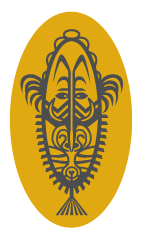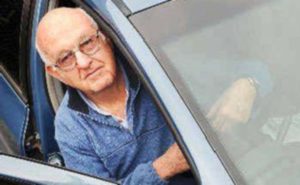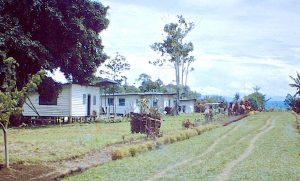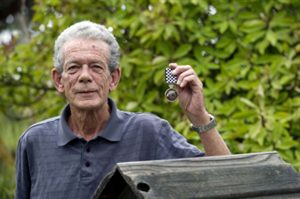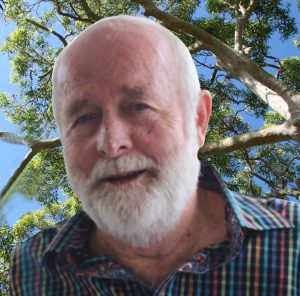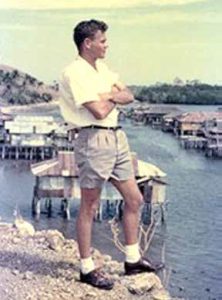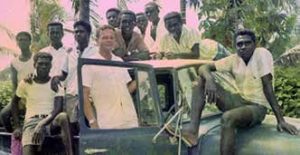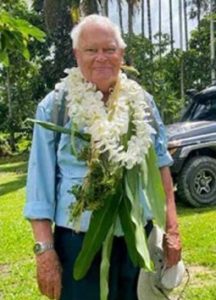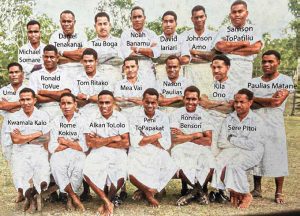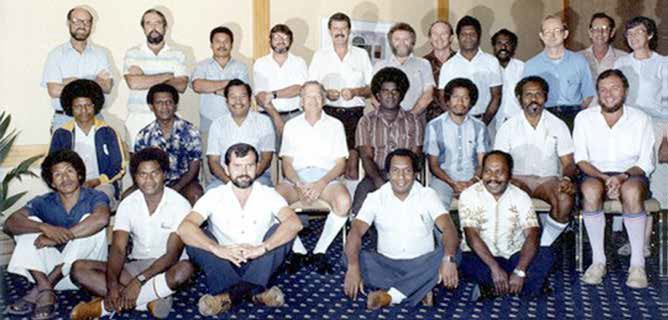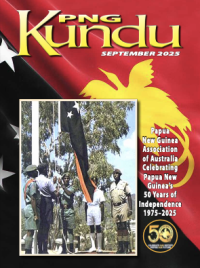VALES SEPTEMBER 2025
BETTERIDGE | BARNETT | DWYER | HUNTER | MELLOR | TOBIN | MURRAY
BETTERIDGE, Charles
22 June 2025, aged 88
Charles was born in Lismore NSW, Australia, on 2 November 1937. Charlie, as he was also widely known, first arrived in Port Moresby, in the Territory of Papua and New Guinea, on 8 April 1960 to work as a spare parts salesman for Burns Philp in Port Moresby.
Toyota Motor Corporation, Japan, approached Burns Philp in 1962 requesting the company become their agent for Toyota motor vehicles, and in February 1963 an agreement was finally reached appointing Burns Philp, through its subsidiary company, PMF. Thus commenced Charles Betteridge’s 30 years direct association with Toyota in Papua New Guinea.
Over the years, Charles became well-liked by the wide-spread team at Ela Motors and, in his eventual role as Parts Manager PNG, he travelled regularly to the various branches around the country. He had an incredible memory for part numbers in particular, and he both established and maintained fastidious parts records nationwide.
Charles was not only associated with Papua New Guinea as, in his later years the company utilised his valuable parts experience in other locations across the South Pacific, covering Ela Motors in the Solomon Islands, and Asco Motors in Vanuatu, Tonga, Samoa, American Samoa and the Fiji Islands as well.
Right from the beginning, Charles became a dedicated Toyota man. He was involved in the first local sale of Toyota motor vehicles in 1963 through Burns Philp in Port Moresby. Records held by Charles recalled his early days in Port Moresby when he first met his charming wife, Penny, in 1966. They married a year later in the old Catholic Church near Ela Beach. Their only daughter, Ursula, was born in Wewak in October 1975.
Charles displayed a keen interest in his early days in the martial art of Judo, and joined the newly-formed Port Moresby Judo Club in 1961. He was fortunate to visit Japan a few years later in 1965 for six weeks to enhance his Judo training at the Kodakan in Tokyo, Headquarters of the world-wide Judo community.
It was recorded that Charles Betteridge was the first person from Papua New Guinea to actually train at the Kodakan. Whilst there, he also spent constructive time with Toyota Motor Corporation.
Charlie’s detailed records include memorable occasions that he experienced in PNG such as self-government in December 1973, followed by the Royal Visit of Her Majesty Queen Elizabeth 11 in February 1974, when the Royal Yacht Britannia visited Kieta in Bougainville where Charles was located at the time. Then came Independence in 1975.
The visit to Papua New Guinea in July 1986 by Mr Eiji Toyoda, Chairman of TMC world-wide, was a special event and involved Charles Betteridge in his role as Parts Manager PNG, resulting in a special Award presented by Adrian Collins, Managing Director, to Charles for Long Service and loyalty to the company.
Some 27 years later, Charles and his wife Penny were cordially invited to return to PNG in September 2013, by Toyota Tsusho South Pacific, to participate in Ela Motors 50th Anniversary Gala Event held at the Crowne Plaza Hotel. At the time Charles said there were over 140 guests present and it was a most memorable conclusion to his years spent in Papua New Guinea.
Charles will be sadly missed by the many people that he encountered over his decades spent in the South Pacific. He was a good friend. An honest and totally trustworthy person who could always be relied on whenever help or advice was needed. RIP Charlie. You were one of the very best. May God Bless You.
Gerry Peacock
BARNETT, Thomas Edwin (Tos)
1935–2025
Further information to come.
DWYER, Patrick Virgil
March 2025, aged 87
Pat was born in Burnie, Tasmania on 7 April 1938. As the son of a school head-teacher he had a number of transfers and changes of primary schools before being enrolled as a border at St Virgil’s College, Hobart.
Pat commenced work with the GPO in 1955 but found it boring and was never happy with Tasmania’s relatively cold climate.
He successfully applied for a position, advertised by the Department of Territories, as a cadet patrol officer and attended the short course at ASOPA along with others of the August 1956 intake.
Pat’s first posting was to the Southern Highlands District where he served at Mendi and Ialibu. The local population was still living in the stone-age. The climate was similar to Tasmania’s!
During 1957 – 58 he completed the correspondence course all cadets had to undertake before attending a one-year academic course.
After his first leave Pat was posted to Kairuku, Central District, where he spent the whole of 1959. In 1960 he attended the ASOPA Long Course for patrol officers.
Returning to TPNG Pat was posted to the Eastern Highlands District where he spent most of his time as Officer-in-Charge of Karimui Patrol Post. One of his patrols was into the Gulf District amongst the Pawaia people where he was warned that the ‘big man’ at Lake Tebera was boasting that he would be killing and eating the next kiap who tried to enter his area!
Of greater note was Pat’s assistance in saving an Ansett-MAL light-aircraft’s pilot from probable certain death. Taking off from Goroka for Mount Hagen the pilot became stuck and disorientated in bad weather. As darkness fell and stuck above thick cloud cover at over 5,000 metres the pilot was desperate—cold, short of oxygen and lost.
At the request of Madang air traffic controllers, a distress call was broadcast over the ABC’s Port Moresby shortwave just before the 7 pm news.
Into his third Rhum Negrita and hearing the call, Pat stepped outside of his kunai house and could hear the faint sound of an aircraft. Pat raced over to his office and contacted DCA Madang on his Crammond Radio. Air traffic control was then able to give the pilot a course to steer to Madang.
Madang, too, was blanketed by thick cloud. A flare path was illuminated along the airstrip and a DC3 sent up with all its lights blazing. It was seen by the lost pilot who was then able to follow it down to a safe landing in the dark, with hardly sufficient fuel to taxi into a parking bay.
In 1964 Pat decided to take up the position of Business Development Officer. This saw Pat assisting with co-operative societies and helping PNG small businessmen with trade stores and coffee projects.
In December 1965 Pat married Margaret McKenna whom he had met at ASOPA whilst she was undergoing her teacher’s training course.
With a growing family, education needs and future career uncertainty leading up to independence, Pat took his family to Tasmania in 1975. Again, the weather was a hardship to bear, and Pat explored opportunities in Perth and resettled the family there a year later.
Whilst working in the Department of Aboriginal Affairs and then the Department of Sports and Recreation, he obtained his diploma of accountancy and joined the WA Police Force administration until retirement.
One of his proudest moments was when he received the Australian Federal Police Overseas Medal for his contribution in PNG at Parliament House in Canberra on 8 July 2013.
Pat is survived by Margaret and their five children.
Chris Warrillow
HUNTER, James (Jim) Oswald
28 April 2025, aged 87
Jim was born in Gilgandra, NSW, on 17 January 1938 and passed away in Bowen NQLD, on 28 April 2025, one year and 10 months after his wife Jeanette of 60 years, predeceased him.
Jim’s father, John Hunter, had also spent time in the Gulf of Papua as a young engineer in the 1920s, which probably started son Jim’s later interest in working in ‘The Territory’.
I’m told Jim enjoyed the local outdoors from the Castlereagh River to the local sheep and wheat farms.
After Jim finished the available secondary schooling in Gilgandra, he became a boarder at The King’s School in Parramatta. He said his father took him there when he started school and his mother attended the last day of school the year that he finished. Otherwise, he travelled by train. His parents were generally not involved.
Jim enjoyed his time there, which included participating in sports such as boxing, rowing, rugby and swimming, while excelling in subjects like English, history, and wool classing.
After finishing senior school at King’s, Jim tried his hand at a few things before applying for an advertised position in the Territory of PNG. This led to the next phase with Jim working in remote areas of PNG as a patrol officer or kiap from 1960 to 1970.
Jim was firstly stationed on the Sepik River at Ambunti and later in the Southern Highlands at Tari and Koroba.
Jim’s book, Stone Age Moon, recounts his key activities and experiences while working in PNG during that 10-year period. One favourite experience Jim would elaborate on after a few ‘reds’ was when he was called in to lead and apprehend those responsible for a massacre before it escalated. Jim performed a wonderful rugby tackle on a ringleader who had been covered in pig fat. The ringleader was running away from some of Jim’s loyal Huri people who had tracked him down following the Mendi massacre.
During his time in PNG Jim met his future wife, Jeanette, at a party in Sydney whilst on leave in mid-1962, after she tried to take a bottle of rum from his back pocket. Things must have improved after a brief exchange, with Jeanette being shown the stuffed crocodile in the car while being driven home after the party.
Jim stayed there for several days. Jeanette’s parents later recounted the story that Jim had become the house cat, sleeping by the fireplace each night, and they couldn’t get rid of him.
In PNG, Jim also had a love of, and a deep trust in, the local people, as evidenced when going ‘bush’ on patrol for up to six weeks. He was often separated from his new wife, and the growing family, which eventually expanded to include three children: John, Vivienne and Gordon.
As the family reached schooling age and Jim’s remote and distance legal studies advanced, our parents moved back to Sydney in 1970. We lived in Brisbane during 1971, where Jim finalised his legal studies, working as a judge’s associate before being admitted to the bar as a barrister. This saw the family move to Townsville in 1972, after Cyclone Althea struck in December 1971.
Jeanette worked in Townsville part-time as a medical technologist, while Jim hung out his shingle as a new barrister in town. They purchased a block of land outside Charters Towers, where we planted grapes and citrus. We enjoyed exploring the creek and the surrounding bush during our visits.
Jim was involved in promoting junior rugby while in Townsville and, of course, this love of rugby continued on in Bowen, resulting in the development of the Bowen Sports Complex.
In 1977, the Hunter family moved to Acacia Flats, Inverdon, Bowen, a farm they had decided to live on. The family enjoyed the rural lifestyle, which was a mix of hard work, managing cattle and mango trees, along with opportunities for activities such as boating, sailing, fishing, exploring, riding motorbikes, horses, and crabbing.
Jim worked full-time in Bowen for about 25 years in partnership as a solicitor before winding back some activities due to his health. Following some major operations, Jim and Jeanette moved off the farm in 2007 to live at Queens Beach, Bowen. Jim moved into the aged-care facility at Murroona Gardens, Bowen in February 2024, seven months after Jeanette passed away, where he remained, except for some hospital visits and some time back at home when family and close friends visited him.
Note: A longer vale is on www.pngaa.org
John Hunter
Eldest son of ex-kiap, Jim Hunter
MELLOR, Robert Hastings Cunningham MBE
25 February 2025
Bob went to PNG firstly as a patrol officer and then as a lawyer.
Before and after becoming a Papua New Guinea citizen in 1985, he served in various roles in PNG (Kiap, Law Lecturer, Magistrate, LTI Assistant Director, Constitutional Commission Lawyer and PNG Law Society Secretary) giving PNG over 73 years of his life.
He was awarded an MBE in 2008 for services to the PNG Law Society and public administration.
Robert Mellor Jnr
TOBIN, Nita
7 May 2025
Nita served the Papua Ekalesia, the first self-governing church in Papua New Guinea, for many years as an accountant, then worked for several more in the same role with The Bible Society. Nita has spent the past few years in a nursing home. A full tribute on Nita will be forthcoming.
Myra Macey
Neil Murray
21 April 1937–28 May 2025
Neil worked in PNG for 43 years (1958–2001)
‘a country which I still feel to be my home’
Childhood: Neil was born on 21 April 1937 and grew up in Mackay, Queensland. His father was an active communist and often international communists visited their home. Neil applied for a Queensland Teachers Scholarship but was rejected because of his father’s political views. Neil worked initially as a cadet draftsman for the Queensland Irrigation and Water Supply Commission.
In 1955 he heard about a Federal advertisement for Cadet Education Officers in the Territory of Papua New Guinea. He applied and was accepted and started his training at Bathurst Teachers College on 5 March 1956. He also attended courses at the Australian School of Pacific Administration (ASOPA) over the two years.
Sogeri: He arrived in Port Moresby on 17 January 1958 for orientation before a challenging posting at the one-teacher Sogeri Primary A School, with European children from Prep to Grade 6. During the first school break he was transferred to Sogeri Secondary School to teach a combined Papua New Guinean Grade 8 class, where many students were older than Neil, and came from various provinces.
Neil remained teaching at Sogeri Secondary School until 1962, during which time he taught students who would become prime ministers, governors-general, heads of government departments and senior public servants.
Neil had passion for photography, and he has self-published his photos and records of his Sogeri years in his book, Education Officer TPNG. Neil ran a cadet program at the school and students with leadership potential attended a training camp at Taurama Barracks.
During one exercise when the cadets were divided into two groups, Ramu Diro, who was the COU, asked permission to raid the other ‘Idubada’ group at dawn. Neil was promised that only water bombs would be used and gave permission. At dawn there was a terrible noise with gun shots using blanks that Ramu Diro had collected during earlier exercises, and Gerega’s shirt was matted with blood from a blank bullet and had to be rushed to the Taurama hospital where his surface wound quickly healed.
Neil enjoyed the irony of PNG’s first Defense Commander shooting the future Minister for Defense.
He enjoyed travelling to the students’ home villages along the Papuan coast and took many photographs that are included in his book.
Leadership Class: In 1962 Neil was involved in running a special Queensland Junior Certificate class for twenty promising PNG public servants. They included students who would later be Prime Minister, Governor General, Education Secretary, Teaching Service Commissioner, Chairman of the Public Service and many other senior positions in the private and public sectors. Neil wrote:
Many of these men played critical roles in the lead up to and implementation of Independence and I am proud to have been part of it all.
Malabunga High School: Neil was appointed to Malabunga High School in Rabaul, East New Britain Province, after leaving Sogeri in 1963 where he taught for a number of years.
Hutjena High School, Buka: In 1967 Neil was appointed headmaster of Hutjena High School in Buka, Bougainville, where he remained until 1973.
Neil documented the dramatic social changes that occurred during his six years as headmaster developing a new high school from the original primary school at Hutjena on Bougainville.
Neil developed close bonds with his students and visited many of their villages travelling throughout the province taking photos that are in his book, Hutjena High School, Buka. Neil oversaw a major building program at the school constructing new classrooms and staff housing, water tanks and furniture that allowed the new grades to be added each year to the high school.
The school site was a Japanese base during the World War II and so many war relics were brought to the school. When Neil asked how a student knew a pair of glasses were from a Japanese soldier the student replied that he had taken them off a Japanese soldier’s skeleton.
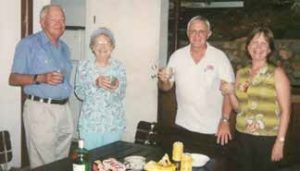
Neil at the 1987 Inspector ratings conference at the
end of 1986 when he handed over the position to his
understudy, Damian Rapese; and with ex-Bougainville
friends Christine Leonard and her mother, Merle Wall,
and Keith Stebbins in Port Moresby
Neil’s book has photos and cultural information about the Panguna mine, and cultural information about the Polynesian Mortlock Islands.
School Inspector: Neil was appointed the East Sepik Inspector after leaving Hutjena in 1973.
Superintendent Secondary and Vocational Inspections: Neil was promoted to Superintendent Secondary & Vocational Inspections after being Inspector in the East Sepik. This was an important step as it led to Neil’s prominence and influence at Waigani HQ.
After that Neil had short periods of ‘retirement’ in Australia but kept returning to PNG, being called back to fill various roles.
Port Moresby: Neil’s organisational and publishing skills were recognised and he was promoted as a project officer and writer in the Materials Section of the Curriculum Unit in Port Moresby. He wrote a set of Social Science booklets and cultural maps during this time.
He also provided support to former Papua New Guinean students and teachers such as Peter Baki and Damien Rapese, both who held senior education positions. Their families became strong friends and Neil often visited them after he retired back in Australia.
Retirement: In 2001 Neil first retired to Mackay, but then relocated to Cairns to be closer to PNG flights and ex-PNG educationalists living there such as Dan Doyle, Herb Golightly, Brian Norris, John Hughes, Julie Andrews and myself.
Neil enjoyed exploring the world and went on many overseas trips, but most trips were to see friends in Papua New Guinea.
Neil’s Support: Dan Doyle and I visited Neil in Cairns a week before he died from cancer and saw that Neil was extremely well cared for by his sister Bette, sister-in-law Tas and Aisa Golina. Neil also shared that he had supportive weekly phone calls from Peter Baki and Damien Rapese.
Vale Neil Murray
You served Papua New Guinea education with distinction
A TRIBUTE BY KEITH STEBBINS
